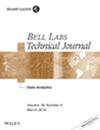下载PDF
{"title":"CPRI接口的LTE/LTE- a信号压缩","authors":"Bin Guo, Wei Cao, An Tao, Dragan Samardzija","doi":"10.1002/bltj.21608","DOIUrl":null,"url":null,"abstract":"<p>The Centralized, Cooperative, Cloud Radio Access Network (C-RAN) is a next-generation wireless access network architecture based on centralized processing, collaborative radio, and real time cloud infrastructure. In this architecture, different access technologies (Global System for Mobile Communications (GSM)/Time Division Synchronous Code Division Multiple Access (TD-SCDMA)/Wideband Code Division Multiple Access (WCDMA)/Long Term Evolution (LTE)) can be supported on the same hardware platform in a baseband pool system, which can largely reduce system costs. Long Term Evolution (LTE) and Long Term Evolution-Advanced (LTE-A), which are based on Orthogonal Frequency Division Multiplexing (OFDM) and multiple input multiple output (MIMO) technologies, are regarded as the main wireless access technologies in the evolution from 3G to 4G. A variety of novel technologies such as multi-antenna MIMO, carrier aggregation (CA), and coordinated multipoint have been introduced in LTE/LTE-A to improve system performance, especially in the C-RAN architecture. However, one of the technical challenges for the C-RAN architecture is the fiber bandwidth required for data transmission between the remote radio unit (RRU) and the baseband unit (BBU). We propose using a low-latency baseband signal compression algorithm to solve this problem by reducing the fiber data rate. Using the characteristics of the LTE signal data, we remove the redundancy in the spectral domain. We also leverage block scaling in conjunction with using a linear or nonlinear (non-uniform) quantizer to minimize quantization error. This algorithm effectively reduces the amount of data transmitted between the BBU and RRU, and facilitates the deployment of LTE in the C-RAN architecture. We verified the robustness of the algorithm via simulations and lab tests. The proposed algorithm yields good system performance at a 1/2 compression rate and at a 1/3 compression rate in a practical propagation environment. © 2013 Alcatel-Lucent.</p>","PeriodicalId":55592,"journal":{"name":"Bell Labs Technical Journal","volume":"18 2","pages":"117-133"},"PeriodicalIF":0.0000,"publicationDate":"2013-08-28","publicationTypes":"Journal Article","fieldsOfStudy":null,"isOpenAccess":false,"openAccessPdf":"https://sci-hub-pdf.com/10.1002/bltj.21608","citationCount":"102","resultStr":"{\"title\":\"LTE/LTE-A Signal Compression on the CPRI Interface\",\"authors\":\"Bin Guo, Wei Cao, An Tao, Dragan Samardzija\",\"doi\":\"10.1002/bltj.21608\",\"DOIUrl\":null,\"url\":null,\"abstract\":\"<p>The Centralized, Cooperative, Cloud Radio Access Network (C-RAN) is a next-generation wireless access network architecture based on centralized processing, collaborative radio, and real time cloud infrastructure. In this architecture, different access technologies (Global System for Mobile Communications (GSM)/Time Division Synchronous Code Division Multiple Access (TD-SCDMA)/Wideband Code Division Multiple Access (WCDMA)/Long Term Evolution (LTE)) can be supported on the same hardware platform in a baseband pool system, which can largely reduce system costs. Long Term Evolution (LTE) and Long Term Evolution-Advanced (LTE-A), which are based on Orthogonal Frequency Division Multiplexing (OFDM) and multiple input multiple output (MIMO) technologies, are regarded as the main wireless access technologies in the evolution from 3G to 4G. A variety of novel technologies such as multi-antenna MIMO, carrier aggregation (CA), and coordinated multipoint have been introduced in LTE/LTE-A to improve system performance, especially in the C-RAN architecture. However, one of the technical challenges for the C-RAN architecture is the fiber bandwidth required for data transmission between the remote radio unit (RRU) and the baseband unit (BBU). We propose using a low-latency baseband signal compression algorithm to solve this problem by reducing the fiber data rate. Using the characteristics of the LTE signal data, we remove the redundancy in the spectral domain. We also leverage block scaling in conjunction with using a linear or nonlinear (non-uniform) quantizer to minimize quantization error. This algorithm effectively reduces the amount of data transmitted between the BBU and RRU, and facilitates the deployment of LTE in the C-RAN architecture. We verified the robustness of the algorithm via simulations and lab tests. The proposed algorithm yields good system performance at a 1/2 compression rate and at a 1/3 compression rate in a practical propagation environment. © 2013 Alcatel-Lucent.</p>\",\"PeriodicalId\":55592,\"journal\":{\"name\":\"Bell Labs Technical Journal\",\"volume\":\"18 2\",\"pages\":\"117-133\"},\"PeriodicalIF\":0.0000,\"publicationDate\":\"2013-08-28\",\"publicationTypes\":\"Journal Article\",\"fieldsOfStudy\":null,\"isOpenAccess\":false,\"openAccessPdf\":\"https://sci-hub-pdf.com/10.1002/bltj.21608\",\"citationCount\":\"102\",\"resultStr\":null,\"platform\":\"Semanticscholar\",\"paperid\":null,\"PeriodicalName\":\"Bell Labs Technical Journal\",\"FirstCategoryId\":\"1085\",\"ListUrlMain\":\"https://onlinelibrary.wiley.com/doi/10.1002/bltj.21608\",\"RegionNum\":0,\"RegionCategory\":null,\"ArticlePicture\":[],\"TitleCN\":null,\"AbstractTextCN\":null,\"PMCID\":null,\"EPubDate\":\"\",\"PubModel\":\"\",\"JCR\":\"Q1\",\"JCRName\":\"Engineering\",\"Score\":null,\"Total\":0}","platform":"Semanticscholar","paperid":null,"PeriodicalName":"Bell Labs Technical Journal","FirstCategoryId":"1085","ListUrlMain":"https://onlinelibrary.wiley.com/doi/10.1002/bltj.21608","RegionNum":0,"RegionCategory":null,"ArticlePicture":[],"TitleCN":null,"AbstractTextCN":null,"PMCID":null,"EPubDate":"","PubModel":"","JCR":"Q1","JCRName":"Engineering","Score":null,"Total":0}
引用次数: 102
引用
批量引用

 求助内容:
求助内容: 应助结果提醒方式:
应助结果提醒方式:


